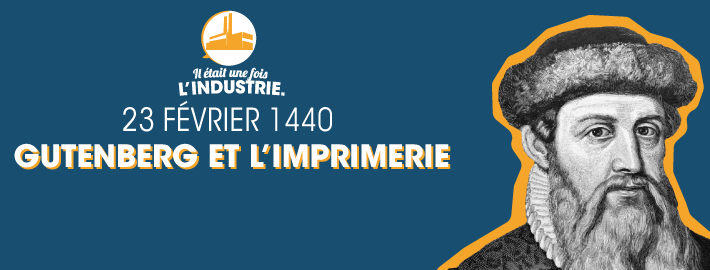GLOBAL
INDUSTRIE
News
Share on

23 February 1440: Gutenberg and the printing press
This week we turn our attention to a major invention which was revolutionary in many ways… and to its eventful birth.
A MAN OF LETTERS
Actually christened Johannes Gensfleisch, our hero took the name under which he was to go down in history from the sign on his parents’ house in Mainz where he was born around 1400: “Zu Guten Bergen”, which means “To the good mountain” in German. His father was a wealthy goldsmith who also held the prestigious position of Master of the Mint to the local archbishop. Johannes thus took an interest in metal processing from his earliest childhood. Just as he was about to follow in his father’s footsteps, however, a local uprising forced him to flee the city in 1428.
He then settled in Strasbourg where, coming up against the monopoly of local craftsmen, he was unable to establish himself as a goldsmith. It was perhaps this failure which drove him to put his metallurgical talents to other uses. It was around 1440 that he developed a revolutionary technique of which he gave the first demonstration, according to various accounts, on the 23rd of February of the same year.
AN INVENTION WHICH MADE A BIG IMPRESSION
His idea was to create metal characters that were movable, and therefore reusable at will, to print texts using a press. Using a steel punch, the hollow letter was first of all printed in a small copper block. A molten alloy of lead, tin and antimony invented by him, which had the particularity of melting easily and not deforming upon cooling, was then poured into this matrix. This process implied other innovations such as the introduction of a composition case, an improvement of the existing printer’s press and the making of an ink as strong as glue which did not smear on the page. He met all of these challenges easily.
Line-by-line assembly of the different characters thus obtained made up the page of writing which could then be printed as many times as required and at low cost. The use of movable, reusable and interchangeable characters enabled series printing. A revolution!
IN THE BEGINNING WAS THE BIBLE
Gutenberg returned to his home town of Mainz in 1448. Two years later, he partnered with Johann Fust, a merchant and banker by trade, to finance and promote his invention. This enabled him to begin the printing of his famous Bible. When this was finally completed however, in 1455, Fust demanded the repayment of his debt. As Gutenberg was then unable to pay, he dragged him before the court. The court ordered him not only to hand over his printing press to Fust but also probably to abandon his famous Bible, of which only 48 copies still exist today out of the 200 said to have been published. In 1457, in a supreme betrayal, Fust partnered with Peter Schöffer, who had been Gutenberg’s apprentice but who testified against him in the trial…
Far from being discouraged while his former partner and disciple were profiting from his presses, he created a new workshop which specialized in the printing of administrative documents. In 1465, the Archbishop of Mainz ennobled him and granted him an annuity in kind. Gutenberg died in Mainz three years later, on the 3rd of February 1468, leaving behind him an invention which was to accelerate the dissemination of ideas and facilitate the advent of the Renaissance in Europe!
"In its printed form, thought is more imperishable than ever; it is volatile, irresistible, indestructible." – Victor Hugo
OTHER EVENTS WHICH HAPPENED THIS WEEK:
- 21 February (1804): a steam locomotive built by the British inventor Richard Trevithick runs for the first time
- 21 February (1842): James Greenough patents the first sewing machine in the United States
- 21 February (1947): the American inventor Edwin H. Land, founder of Polaroid, presents his instant camera to the Optical Society of America
- 23 February (1440): Gutenberg gives his first demonstration of the printing press
- 25 February (1836): the American inventor Samuel Colt patents the revolver named after him
- 25 February (1837): his compatriot Thomas Davenport receives a patent for the first industrially usable electric motor
- 25 February (1899): official creation of Renault
- 26 February (1935): a radar detects an aircraft for the first time
- 26 February (1949): a Boeing B50 makes the first non-stop flight around the world in 94 hours
- 27 February (1861): the telegraph invented by the American Samuel Morse arrives in France
2022.02.21